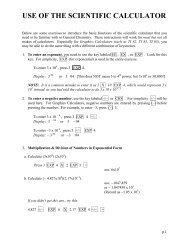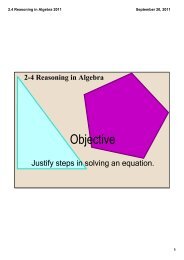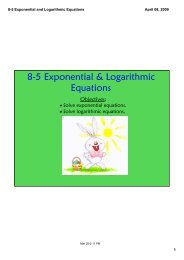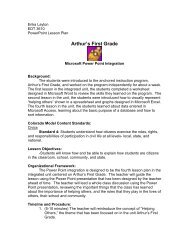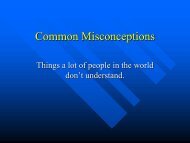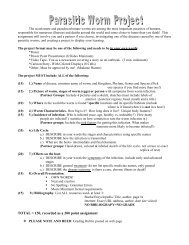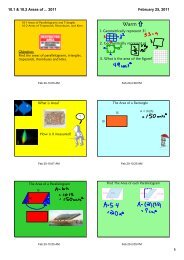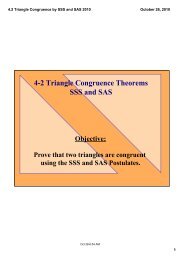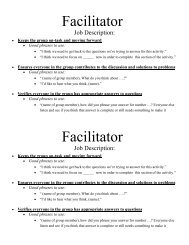Electrochemistry PowerPoint
Electrochemistry PowerPoint
Electrochemistry PowerPoint
You also want an ePaper? Increase the reach of your titles
YUMPU automatically turns print PDFs into web optimized ePapers that Google loves.
<strong>Electrochemistry</strong>Reduction-Oxidation Reactions
Reduction-Oxidation We usually call it “redox” for short. Oxidation originally meant “combiningwith oxygen.” Reduction originally meant “combiningwith hydrogen.” Modern definitions are broader. Oxidation: Losing electrons. Reduction: Gaining electrons.
Redox An easy way to remember what happensin redox reactions is to use this littleacronym. LEO goes GER. Losing Electrons is Oxidation. Gaining Electrons is Reduction.
An Example Magnesium reacts with sulfur to form acompound. Mg(s) + S(s) MgS What are the charges of each of thereactants and products? 0 0 2+ 2- Mg + S MgS What happened electronically during thereaction?
An ExampleA Lewis dot diagram is a simpleway to show what happens.Mg2+ 2-S
RedoxLose 2 e - = oxidation 0 0 2+ 2-Mg + S MgSGain 2 e - = reduction
Half-Reactions It is often useful to separate theoxidation part of the reaction from thereduction part. But please remember, it is impossibleto have one without the other. Electrons can’t disappear, so if onesubstance is being oxidized, somethingnearby must be getting reduced.
Half-Reactions Oxidation half-reaction: Mg Mg 2+ + 2 e - Reduction half-reaction: S + 2 e - S 2- When redox reactions occur, the totalnumber of electrons lost by onesubstance must equal those gained bythe other.
Oxidation Number Rules Keeping track of electrons involvesknowing a few basic rules. Any element, whether it is a free atom orpart of a molecule or ion can beassigned an oxidation number. Sometimes the number represents anactual charge, but often it does not. It is simply an electronic bookkeepingsystem.
Oxidation Number Rules1. Free elements (including theHOFBrINCl’s) have ox. # = 0.Ex. K(s) = 0 Cl 2 (g) = 02. Single atom ions: ox. # = ionic charge.Na + = +1 Cl - = -13. All ox. #s in a neutral compound mustadd up to 0.Al 2 O 3 : (2 x 3 + ) + (3 x 2 - ) = 0
Oxidation Number Rules4. All ox. #s in a polyatomic ion must add upto the charge of the ion.5. Oxygen in a compound is nearly always -2.(Exceptions: peroxides O 22- (with a columnIA or IIA metal), O is -1, or in OF 2 , O is +2.)6. Hydrogen in a compound is nearly always+1. (Exception: H with a column IA or IIAmetal. H is the anion. Hydride = -1. Ex.NaH, CaH 2 ).
Examples +2 +4 -2 +3 -1 Ca C O Al Br 33 +2 +4 -6 = 0 +5 -2 0 P O3- 4 Ag(s) +1 -2 +1 -1 H K Cl2 O +5 + (4 x -2) = -3
ExamplesO 3 Na N +2 + 10 – 12 = 0 +2 -2 +1 -1 Fe O K 2 O 2 +3 -2 -3 +1 -1 Fe 2 O 3 N H 4 Cl +2 +5 -2 +1 +5 -2 Mg (N O 3 ) 2
Multiple Oxidation States Find the ox. # of N Answers:in these substances.1. N 21. 02. NH 32. -33. NO3. +24. N 2 O4. +15. NO 25. +46. N 2 O 36. +37. N 2 O 57. +5
Oxidizing and ReducingAgents An electron taker causes the oxidation ofanother element and so may be thoughtof as an oxidizing agent. Oxidizing agents are reduced. Likewise, an electron giver causes thereduction of another element and so canbe thought of as a reducing agent. Reducing agents get oxidized.
Oxidation Number Method This method is useful when completereactions are given.1. Write the complete equation and assignoxidation numbers to all elements.2. Identify the elements oxidized (ox. # ↑)and reduced (ox. # ↓).3. Use lines to connect the elementsbeing oxidized and reduced. Show thechange in oxidation number.
Oxidation Number Method4. Make the total change in oxidationnumbers equal. Electrons gained mustequal electrons lost.5. Balance any remaining atoms byinspection. Let’s do an example.
Oxidation Number Method-3 (gain 3 e - )-3 x 2 = -6+3 -2 +2 -2 0 +4 -2Fe 2 O 3 + 3 CO 2 Fe + 3 CO 2+2 (lose 2 e-) +2 x 3 = +6Lowest common multiple of 3 and 2 is 6.Put in the coefficients to balance the electrons.Check the oxygen: 6 on both sides.
Half-Reaction Method Often, the spectator ions are left out of areaction. Also, the reaction may say “inacid” or “in base” indicating conditionsthat can be used to balance theequation. In this case, it is best to use the halfreactionmethod to balance the equation. Here are the steps of the method.
Half-Reaction Method1. Write the unbalanced ionic reaction.2. Write the half reactions for the oxidationand reduction.3. Balance the atoms being oxidized andreduced. (You may need to check theoxidation numbers to be sure whichones they are.)4. Balance oxygen by adding water to theother side of the equation.
Half-Reaction Method5. Balance the hydrogen atoms on eachside by adding H + . (If the reaction is inbase, next add enough OH - to eachside to neutralize all the H + .)6. Balance the charge on both sides ofeach half-reaction by adding electrons.The net charge on both sides of eachequation should be equal.
Half-Reaction Method7. If necessary, multiply one or both halfreactionsby a factor that will makeelectrons lost = electrons gained.8. Add the half-reactions together, cancelany common terms, including electrons,and make sure any remaining atomsare also balanced.
Example 1. Write unbalanced ionic equation. S + NO 3- SO 2 + NO in acid. 2. Separate into half-reactions. S SO 2 NO 3- NO 3. Balance atoms being ox. and red.There is one S and one N on each side.
Example 4. Balance oxygen using water. 2 H 2 O + S SO 2 NO 3- NO + 2H 2 O 5. Balance H using H + 2 H 2 O + S SO 2 + 4 H + 4 H + + NO 3- NO + 2H 2 O
Example 6. Balance the net charge on both sideswith electrons. 2 H 2 O + S SO 2 + 4 H + + 4 e - Net charge now 0 on both sides. 3 e - + 4 H + + NO 3- NO + 2H 2 O Net charge now 0 on both sides. (The net charge does not have to be 0, itjust needs to be equal.)
Example 7. Make electrons lost = electronsgained. Low common multiple of 3 and 4 is 12. [2 H 2 O + S SO 2 + 4 H + + 4 e - ] x 3 [3 e - + 4 H + + NO 3- NO + 2H 2 O] x 4
Example [2 H 2 O + S SO 2 + 4 H + + 4 e - ] x 3 6 H 2 O + 3 S 3 SO 2 + 12 H + + 12 e - [3 e - + 4 H + + NO 3- NO + 2H 2 O] x 4 12 e - + 16 H + + 4 NO 3- 4 NO + 8 H 2 O
Example Add equations together, cancel commonterms and give a final check. 6 H 2 O + 3 S 3 SO 2 + 12 H + + 12 e -4 H +2 H 2 O 12 e - + 16 H + + 4 NO 3- 4 NO + 8 H 2 O 4 H + + 3 S + 4 NO 3- 4 NO + 3 SO 2 + 2 H 2 O



